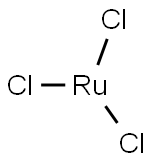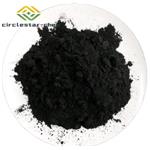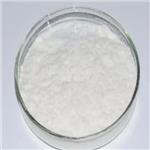Chemical Properties
The trihydrate, RuCl3·3H2O, is the usual commercial form. Aqueous solutions of the trihydrate are a straw color in dilute solution and red-brown in concentrated solution. Ruthenium (III) chloride in solution apparently forms a variety of aquo- and hydroxy complexes.
Physical properties
Ruthenium(III) chloride is a reddish brown or black leafy crystal, easily deliquescent. It forms a dark red solution. Relative density 3.11, decomposed into monomers when it is higher than 500°C. It is insoluble in cold water and carbon disulfide. Insoluble in cold water and carbon disulfide, decompose in hot water, insoluble in ethanol, soluble in hydrochloric acid.
Uses
Ruthenium(III) chloride is widely used as a starting material of ruthenium complexes. It acts as a catalyst used in the oxidative cyclization of 1,7-dienes to oxepane diols. It is used in the hydroxylation of tertiary hydrocarbons in combination of periodate or bromate. It is involved as a catalyst in the synthesis of 2,3-pyridinedicarboxylic acid-13C3, 15N, where the unlabelled analog is an inhibitor of glucose synthesis.
Application
Ruthenium(III) trichloride is highly toxic and finds application in chemistry laboratories for technical analysis, particularly in the testing of sulfur trioxide. Ruthenium trichloride is by far the best starting material for the synthesis of compounds of the metal. Like osmium, ruthenium exhibits a wide range of oxidation states in its complexes (VIII to —II), and all of these may be reached from RuCl3 since, although it is stable, it can easily be oxidised or reduced. It is most commonly used in the hydrated form, this being soluble in many solvents, but for anhydrous or solid-state reactions β-RuCl3 is the best source.
Production Methods
RuCl3, is made by direct chlorination of the metal at 700 °C (1,292 °F). Two allotropic forms result. The trihydrate is made by evaporating an HCl solution of ruthenium (III) hydroxide to dryness or reducing ruthenium (VIII) oxide in a HCl solution.
Reactions
Ruthenium(III) chloride interacts with potassium iodide to produce an iodide precipitate, precipitates as ruthenium trisulphide when hydrogen sulphide is introduced into the solution, and can form the corresponding ammonia, cyanide, and nitrite complexes with ammonia, potassium cyanide, and potassium nitrite complexes, and is reduced to blue divalent ruthenium ions when interacting with sodium amalgam or titanium trichloride.
reaction suitability
core: ruthenium
reagent type: catalyst
reaction type: Atom Transfer Radical Polymerization (ATRP)
Safety Profile
Poison by intraperitoneal route. Incompatible with iron pentacarbonyl and zinc. When heated to decomposition it emits toxic fumes of RuO, and Cl-. See also RUTHENIUM COMPOUNDS.






